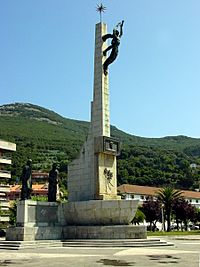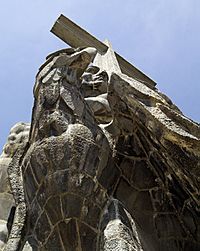Juan de Ávalos facts for kids
Juan de Ávalos y García-Taborda (born October 21, 1911, in Mérida – died July 7, 2006, in Madrid) was a famous Spanish sculptor. He created many large and important sculptures across Spain and in other countries. His art is known for its grand scale and powerful figures.
Contents
Early Life and Artistic Beginnings
Juan de Ávalos started learning art at a very young age. When he was just six years old, he had a special teacher named D. Juan Carmona. This teacher was a pastor who taught Juan and three other children how to draw.
Soon after, Juan's family moved to Madrid. His father's eyesight was getting worse, which made the move necessary. In Madrid, Juan's father showed his son's drawings to a well-known painter, Manuel Benedito.
Discovering a Young Talent
Manuel Benedito was very surprised by the drawings. He couldn't believe a child had created such good artwork. To see for himself, he watched Juan de Ávalos as he worked. Convinced of the boy's amazing talent, Benedito advised Juan's father. He told him to take young Juan to the Casón del Buen Retiro, a famous art center. This helped Juan continue his artistic journey.
Famous Sculptures and Monuments
Juan de Ávalos created many impressive sculptures throughout his life. Some of his most well-known works are found in Spain.
Key Works in Spain
One of his famous pieces is Los amantes de Teruel (The Lovers of Teruel). This sculpture is located in Teruel, a city in Spain. He also made the Monumento a Luis Carrero Blanco (Monument to Luis Carrero Blanco) in Santoña, Cantabria.
The Valley of the Fallen
Among his most important creations are the sculptures at the Valle de los Caídos ("The Valley of the Fallen"). This is a very large and majestic monument near Madrid. It features many grand sculptures that show his skill.
Personal Life
Juan de Ávalos married María de la Soledad Carballo y Núñez in 1937. They had two sons together, named Juan and Luis. Juan de Ávalos passed away in Madrid at the Clínica Virgen del Mar.
Other Notable Works
Juan de Ávalos created many other significant sculptures. Here are some of them:
- El Héroe Caído (The Fallen Hero), Badajoz, 1950-1956
- Marinos caídos en el Mediterráneo (Sailors Fallen in the Mediterranean), Benidorm, 1963
- Ángel de la Victoria y de la Paz (Angel of Victory and Peace), Valdepeñas, 1964
- Cristo de la Paz (Christ of Peace), Almendralejo, 1965
- Monument to Franco, Santa Cruz de Tenerife, 1966
- Arco del Triunfo a la Independencia (Arch of Triumph for Independence) in the Dominican Republic
- Los Monteros (or Monument to Covarsí), Badajoz, 1968
- Genio de Extremadura (Genius of Extremadura)
- La Ciudad y el Río (The City and the River)
- Bernardo de Gálvez, Washington, D.C., 1976
- Extremeños Universales (Universal People from Extremadura), Badajoz, 1983
- Monument to Count Diego Porcelos, Burgos, 1983
- Pope John Paul II, Madrid, 1998
See also
 In Spanish: Juan de Ávalos y Taborda para niños
In Spanish: Juan de Ávalos y Taborda para niños




